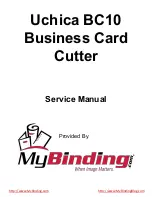
Armfield Instruction Manual
20
10. Ensure that the isolating valve (23) upstream of each spray nozzle is fully
open. Connect the flexible tube from the overhead sprinklers to the quick
release connector (15) on the feed outlet above the 3 l/min flowmeter. Open
the appropriate feed flow control valve (13) fully then switch on the pump.
Adjust the corresponding pressure regulator (12) to give a reading of 2.5
litres/min on the corresponding flow meter (14). (To change the setting of the
pressure regulator, pull the grey knob upwards then rotate the knob clockwise
to increase the flow, anticlockwise to decrease the flow). Observe that water
is delivered smoothly to the spray nozzles after initial priming/purging of the
air. Check that the sprinkler system is leak tight. Leave the spray nozzles
operating.
11. Connect the flexible tube from the base of the river inlet tank (17) to the quick
release connector (15) on the other feed outlet. Open the appropriate feed
flow control valve (13) fully then adjust the corresponding pressure regulator
(11) to give a reading of 5.0 litres/min on the flow meter (14). Observe that
water fills the river inlet tank then flows into the sand tank via the channel
section. Check that the river inlet system is leak tight. Leave water flowing
into the sand tank.
12. With water in the sand tank open the well control valves (32) fully and check
that water is returned to the sump tank - the flexible tubing (32) must divert
water back to the sump tank. Check the system for leaks.
13. Close both well flow control valves (32) and allow the water level in the sand
tank to increase until level with the top of the stop-logs - approximately half
full. Switch off the pump and close the feed flow control valves.
14. Place a single drop of wetting agent in each manometer tube (20) to minimise
the effect of surface tension. Fill the outer tubes with clean water until
approximately half full. These two tubes are connected and form a U tube that
can be used for levelling the manometer. Unclamp the manometer and adjust
the position until the level is the same in both tubes – using the moving scale
to measure the height.
15. Disconnect the flexible tube from the base of each manometer tube in turn
(except the outer pair) and allow water to flow into a suitable receptacle until
all air is expelled from the tubing between the tapping (37) in the bed of the
sand tank and the free end of the tube. When correctly primed the level in
each manometer tube should be the same corresponding to the free surface
of the water inside the sand tank. Any tube indicating a higher or lower level
should be re-primed.
16. Ensure that the outlet collecting tank (28) is clean and in position beneath the
weir chute/diffuser at the end of the sand tank. Ensure that the clear
polythene skirt with slits is attached to the bottom of the weir chute/diffuser
using an elastic band. This prevents splashing when water and sand fall into
the collecting tank. Place a drop of wetting agent inside the inclined
manometer tube on the side of the tank. Open the flow control valve (13) to
the river inlet. Start the pump then adjust the pressure regulator to give a flow
of 3.0 litres/min into the sand tank. Allow water to flow over the stop-logs, into
the weir chute/diffuser (26) and into the outlet collecting tank (28). When the
outlet collecting tank has filled observe that the water flows over the
rectangular notch (27) then flows to the sump tank via the collecting funnel
Summary of Contents for S12-MKII
Page 1: ...Advanced Environmental Hydrology System Instruction Manual S12 MKII ISSUE 21 February 2014...
Page 4: ......
Page 8: ...4 Equipment Diagrams Figure 1 Front View of S12 MKII Hydrology System...
Page 9: ...Equipment Diagrams 5 Figure 2 Plan View of S12 MKII Hydrology System...
Page 10: ...Armfield Instruction Manual 6 Figure 3 End View of S12 MKII Hydrology System...















































